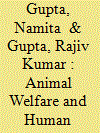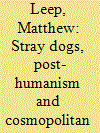| Srl | Item |
| 1 |
ID:
170175


|
|
|
|
|
| Summary/Abstract |
India’s large stray dog population, estimated to be about 25 million, poses substantial risks to human health, motivating some civic bodies to employ cruel methods to control dog populations. This article argues that while human health is certainly a priority, it is also important to consider animal welfare and to handle dog population control measures without causing unnecessary animal suffering. Triangulating the issues of rabies control, dog population management and state intervention, the article identifies recent practical difficulties in local management of dog population control laws and policies in India’s model city of Chandigarh. Based on a survey of local opinions, this shows how rising human–animal conflicts require new ways of handling existing challenges.
|
|
|
|
|
|
|
|
|
|
|
|
|
|
|
|
| 2 |
ID:
161629


|
|
|
|
|
| Summary/Abstract |
International Relations scholars have recently begun exploring the politics of human-animal relations in global affairs. Building on Jacques Derrida’s work on hospitality and animals, this article theorises possibilities of responsibility to animals in war zones, pushing the limits of what it means to be with and for others regardless of their human or animal otherness. Specifically, I develop a critical account of cosmopolitan belongingness to illustrate how our being on earth is always a ‘being-with’ animal others. In thinking through possibilities of post-human belongingness that could emerge in times of war, cosmopolitanism becomes a futural task, an out-of-time and endless confrontation of past and future opportunities for interspecies togetherness. The theoretical significance of this approach is illustrated with a case study on the killing of stray dogs during the Iraq War. This case reveals a cosmopolitanism calibrated to more fully consider possibilities of human-animal belongingness amidst violence.
|
|
|
|
|
|
|
|
|
|
|
|
|
|
|
|